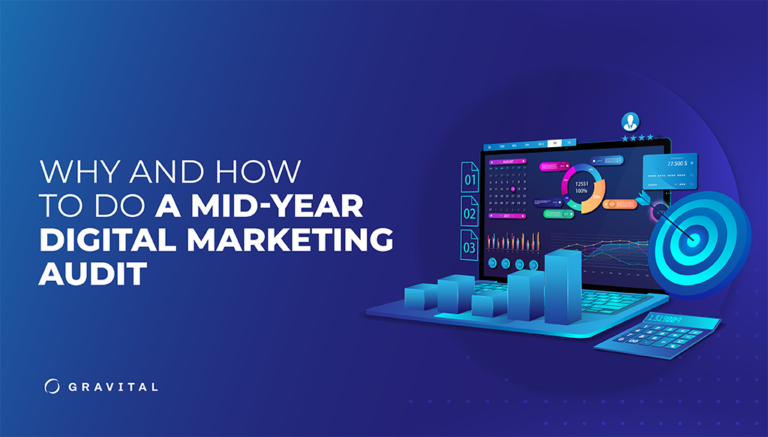Have you ever heard of mid-year digital marketing audits and thought, “Wow, that sounds about as fun as a root canal”? We get it. Audits are not exactly everyone’s favorite pastime. But a marketing audit is an interesting and valuable exercise for your company.
It may seem like just yesterday you mapped out your digital marketing plan, yet here we are, six months later, and it’s time to assess the effectiveness of that plan and adjust it if necessary.
If you don’t know if you’re meeting your marketing, sales and business objectives, and you’re not sure what to do for the second half of the year, keep reading.
What Is a Mid-Year Digital Marketing Audit?
A mid-year digital marketing audit is the process of evaluating the effectiveness of a company’s digital marketing strategies and campaigns halfway through the year, usually in July. The audit helps identify areas of strength and weakness as well as opportunities for improvement that can be used to revise the marketing plan for the rest of the year.
By taking the time to reflect on the first half of the year, brands can make more informed decisions about how to allocate marketing resources and create plans for the rest of the year that are more likely to achieve desired results.


1. Update Your Goals
Evaluate the goals you set for the year and the results you’ve achieved from January until now. Did you meet your goals? Did you neglect any of them? Why? Are they still viable for the next six months?
Observe what’s happening with your business, your competitors and the market, and decide on three to five SMART goals that you want to pursue for the rest of the year.
2. Research Your Target Audience
Who has been consuming your content and buying your products or services? You may discover that you should expand your target audience or narrow it down based on data gathered during the audit. Knowing your target audience, communicating with them and catering to them is the ultimate key to successful digital marketing.
3. Conduct a Content Audit
What has your content accomplished so far this year? What is your return on investment (ROI) from it?
Create a content inventory by examining which platforms performed better and how well they did, as well as which did worse. Use tools such as Google Analytics, SEOptimer and SiteAnalyzer to measure performance.
Your content audit should cover quality, SEO (search engine optimization), strategy alignment, lead generation and conversion optimization for content such as website and landing pages, blog posts, e-Books, video, webinars and podcasts. Make sure you track information such as type of content, the content’s goal, views and engagement, word count, time it took to produce the content, title, author, date, URL and CTA metrics including click-through rate, submission rate and views to submission.
4. Listen to the Data
Start with Google Analytics:
- Where is most of your web traffic coming from?
- Which pages are receiving the most hits?
- How long are visitors spending on them?
- Which types of content are they downloading?
- Where is most of your referral traffic coming from?
- What are your conversion rates?
- What are the visitors sharing
- Where are you getting the most ROI?
After you gather all of your Google Analytics data, check KPIs (key performance indicators) for every other platform you’re using, including social media, email and paid advertising. Then go back to your marketing plan and goals and see if you’re on track to meet them. Invest more in the platforms that are performing best and pull back on under-performing ones.
5. Determine Your Social Media Engagement
Review your social media marketing efforts to determine if they have been effective. Calculate your social media engagement rates by analyzing metrics such as likes, followers, interactions and shares.
ALSO READ: ENSURE THE FUTURE: 10 VITAL DIGITAL MARKETING STRATEGIES FOR INSURANCE BRANDS
6. Evaluate Your Email Marketing
Examine your email open and click-through rates, unsubscribe rates and conversions, among other metrics, to evaluate the effectiveness of your email marketing campaigns.
7. Research Your Competitors
Look into your competitors’ digital marketing tactics to identify trends and areas in which you could improve. Using tools such as Semrush, examine their SEO rankings and other SEO factors such as most successful keywords, total number of keywords with organic positions, expected monthly organic and inorganic traffic, and consumer behavior based on search volume.
8. Check in With Customers
Your marketing plan may serve your business goals but it’s centered on your customers’ needs. The mid-year audit is a good time to check in with your customers to see how well your company is addressing their pain points.
9. Talk to Sales
Are your marketing strategies moving the needle for sales? Meet with your sales team to go over goals, see how things are going halfway into the year. Make sure that your marketing and sales goals are aligned.
10. Adjust Your Digital Marketing Plan
Use the insights gained from your analysis to identify areas of improvement and adjust your digital marketing plan for the rest of the year.
Your revised action plan should include the following information:
- Accomplishments so far this year
- Identified weaknesses and challenges
- Identified strengths and opportunities
- Goals for the following year
- Adjusted marketing budget for next year and the next
11. Monitor Your Progress
Track your progress frequently throughout the year and adjust your digital marketing plan as needed. The more often you audit your efforts and performance, the easier it is to go through this process. Consider doing quarterly check-ins. And don’t rest on your laurels!
And there it is. It wasn’t that painful, was it? With the right approach and a positive attitude, a mid-year audit can be an exciting and beneficial experience for your company.
Do you need help with your digital marketing strategies and audits? Talk to us. Even if all you need is moral support, we’re here.


